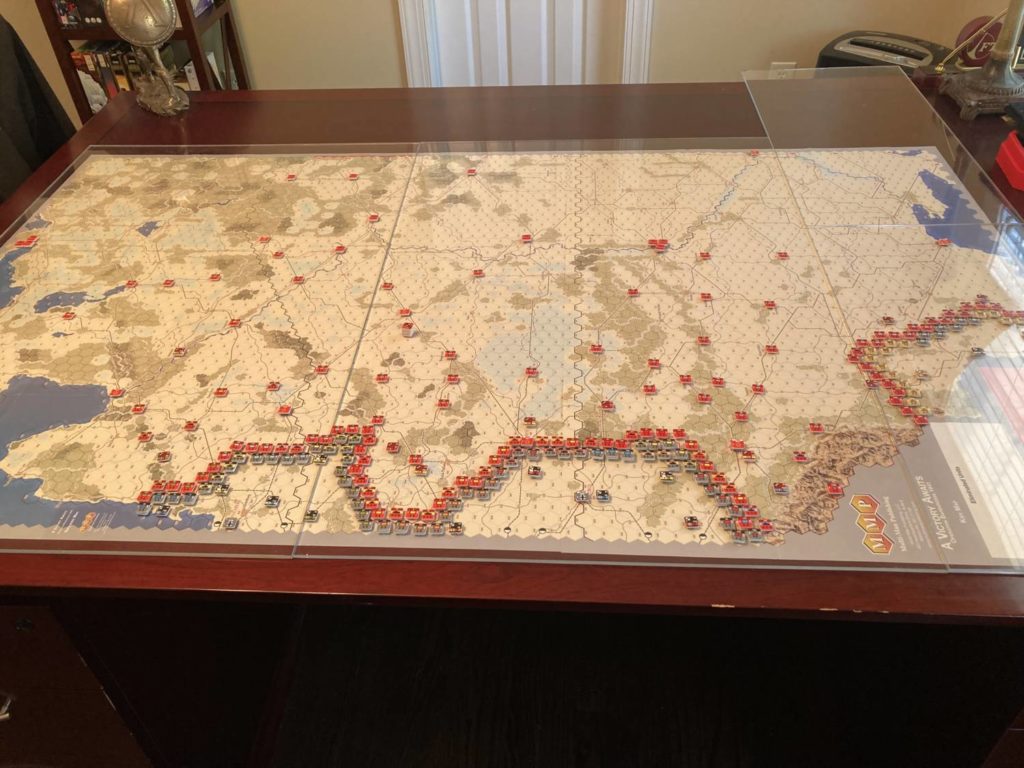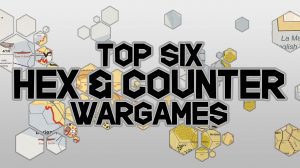Released in 2022 by Multi-Man Publishing (MMP), A Victory Awaits: Operation Barbarossa 1941 (or AVA for short) is a simulation of the first three months of the titanic clash between Germany and the Soviet Union. Designed by Tetsuya Nakamura, AVA is a relatively low complexity hex and counter wargame. Originally released in Japan as three separate games covering the operations of German Army Groups North, Center, and South, MMP combined them into a single box. Players can choose to play each of the individual Army Group games or combine them into one linked campaign.
Victory Conditions
To win the Campaign Game, the German player must accumulate at least 191 victory points (VPs) by the end of Turn 9. VPs are awarded for the capture of each major city hex; 10 VPs if there is a line of communication (LOC) back to Germany or 5 VPs if there is not. Some major cities start with Stand Fast markers on them which the Soviet player can start removing on Turn 6. If a hex containing a Stand Fast Marker is captured, it is worth an additional 5 VPs if there’s a LOC back to Germany and 2 if there is not. In addition, 1 VP is awarded for each Soviet mechanized unit eliminated, and 1 VP for each full-strength German mechanized unit remaining on the board at game end.
Given there are 21 major city hexes, of which only 11 contain Stand Fast markers, the German player will need to aggressively maneuver his Army Groups to encircle and cut off large numbers of Soviet divisions, while also capturing major cities along the way. As we’ll see shortly, the rules make this possible, but perhaps improbable.

Game Mechanics
AVA is driven by a chit-pull mechanism. The Turn Record track identifies the activation markers players get each turn. These are all put into an opaque container and drawn one-by-one. As each chit is drawn it activates the corresponding Army headquarters on the game map. That headquarters can then activate all units, even those belonging to other armies, that are within 4-hexes of its location. This allows some units to move and attack multiple times in a single turn. This is particularly helpful to the German player as it allows him to make deep thrusts with his armored formations.
A Supply chit is included in the cup each turn. When it is drawn, first the Soviet and then the German player must determine if their units have an open LOC back to a friendly supply source. Those that don’t lose a single step (i.e., they are flipped over to their weaker side). If already flipped, the unit is eliminated. Not only do the Germans have the advantage of checking their supply status after the Soviet player, but all German units are automatically in supply through Turn 3. This means the German player can push deep into the Soviet rear early in the game without fear of being cut off, while at the same time cutting off Soviet forces.
As with many hex and counter wargames, each unit exerts a Zone of Control (ZOC) into each adjacent hex. Units must pay two extra movement points to enter an enemy ZOC (even if occupied by a friendly unit), and another two movement points to exit an enemy ZOC. Because Soviet infantry units have a movement allowance of 4-points, they are unable to move from one ZOC hex to another, which severely limits their mobility and makes it difficult for them to escape German encirclements. German infantry units have a movement allowance of 5-points, which is just enough to squeeze past Soviet units. This disparity in mobility extends to armored formations too. German panzer units have a movement allowance of 10-points; Soviet armor units have a movement allowance of only 6-points.

These rules reflect the overall preparedness of the Wehrmacht in terms of training, doctrine, and logistics. By comparison, most Soviet forces in 1941 were under-manned, ill-trained, and poorly equipped. They also suffered from an appalling lack of leadership in their officer corps due to Stalin’s purges in the 1930’s. The supply, ZOC, and movement rules all help recreate this tactical situation early in the war. The Germans were able to run rings around the Russians and were only halted by the vastness of the Soviet Union and the severe winter weather.
What, No Air or Naval Units?
AVA does not include any air or naval units. At first this seemed odd until I remembered the game only covers the first 90-days of the war. At this time, Germany had complete air superiority and destroyed most of the Soviet Air Force on the ground during the first few days. This afforded them a freedom of action not available to the Soviets and is simulated by the difference in unit movement allowances. As for naval forces, the war in the East was largely a land campaign with very little opportunity to employ navies to any significant advantage. Thus, the game’s limited scope allowed the designer to dispense with rules for governing air and naval units and instead abstract them into the unit counters and rules.
Soviet Advantages
So, what if any advantages do the Soviets have in AVA? We’ve already alluded to one – the sheer size of the Soviet Union. Not only is the Soviet Union large, but the front line gets longer the further east you travel. The Germans are effectively starting at the narrow end of a funnel and will have to spread their forces thinner and thinner as they move east. You can see this in the photo for the campaign game setup.

While this also impacts the Soviet player, the rules governing eliminated units and reinforcements more than make up for this. Both players’ armored units are permanently out of the game when eliminated. Armored forces were just not that easy to create or regenerate, especially within the 90-day timeframe of AVA. Not so with infantry. The rules allow eliminated Soviet infantry units, and only Soviet infantry, to re-enter the game as reinforcements on later turns. The one exception are infantry units that are eliminated as a result of being out of supply. These units are assumed to have surrendered and are taken as POWs.
Allowing eliminated Soviet infantry units to re-enter the game means the Soviet player can eventually replenish their losses and fill gaps in the line even as the front itself expands. This acts as a brake on the German player’s forward momentum. Consequently, what appears as a very one-sided game has terrific balance and makes it exceedingly difficult for the German player to obtain the number of VPs needed to win.
Components
As with most MMP releases, the game components are completely serviceable and adequate to the task, but certainly not flashy or deluxe. The game comes with three map sheets: one for Army Group North, one for Army Group Center, and one for Army Group South. These maps can be overlayed to play the entire campaign from the Gulf of Finland to the Black Sea covering an area roughly 34 by 57 inches. The map’s terrain features are easy to distinguish and are annotated with the set-up positions of all the combat units that start the game.
There are roughly 840 half-inch counters in the game, most of which represent division-sized combat units. Armored units have two sets of counters, one with the standard NATO symbol and another with tank silhouettes. Players can choose which they prefer to use. Each division belongs to a specific army which is denoted in both text and by a color. There is a minimum of administrative markers in the game, which when combined with the stacking limit of two units per hex, minimizes clutter.

The 16-page full color rulebook is logically organized and well-written, especially considering it was translated from the original Japanese rules. The rules do include illustrated examples, optional rules, and rules for playing individual scenarios as well as the entire campaign. The campaign rules provide guidance on how to divide up the units to play with up to eight players, although good luck in finding that many. The game also comes with two player aids containing an abbreviated sequence of play, combat results table (CRT) and Terrain Effects Chart (TEC). Two 2-sided scenario turn tracks are provided for the Army Group North, Center, South games, as well as the combined campaign game. There is no separate playbook with an extended example of play or designer notes, but given the relatively simple and streamlined rules, this is not an issue.
Overall Impressions
AVA is a simple and extremely streamlined hex and counter wargame. In fact, despite its size, it could easily be used as an entry point into hex and counter wargames. Game play is fast with little need to consult the rules once you have a turn or two under your belt.
The German player will need to be super aggressive and push their luck if they are to have any chance of achieving the required number of VPs. By contrast, the Soviet player can use delaying tactics to slow down the Germans but must also be careful not to allow huge encirclements that can blow huge holes in the front line.
Unlike many East Front wargames that cover the entire conflict from 1941 to 1945, AVA concentrates on the pivotal opening months of the war. Had the Germans been able to capture Moscow before the onset of winter, the Soviet Union may well have collapsed. As it turned out, the Soviets were able to stop them short of the gates of Moscow despite taking horrific losses. If you’re looking for a relatively short and easy-to-learn wargame that covers these initial months of Operation Barbarossa, AVA could just be what you’re looking for.












Add Comment